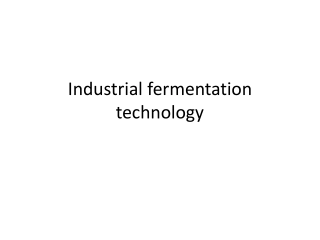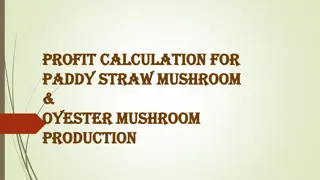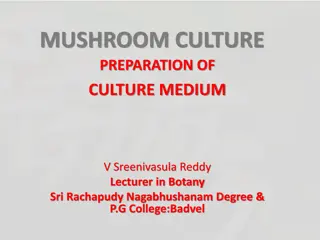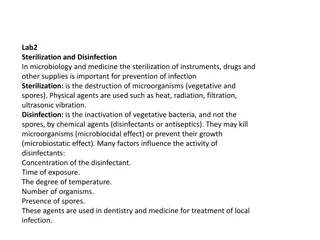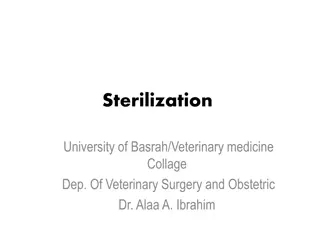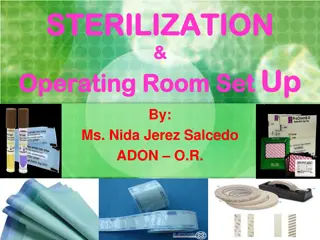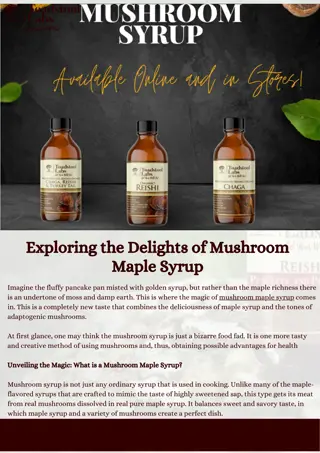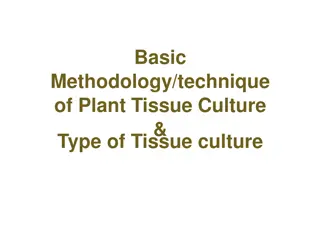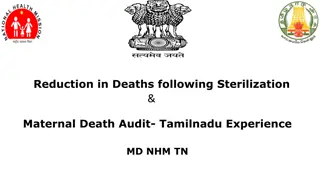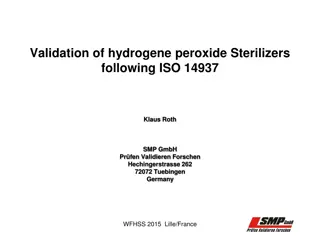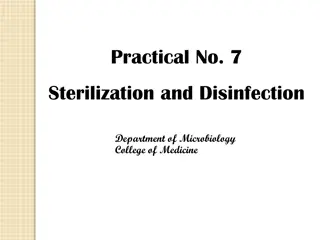Mushroom Culture Sterilization and Slants Preparation Methods
Learn about the sterilization methods for glassware, agar medium, and culture medium in mushroom culture. Understand the preparation of agar slants and culture slants to maintain a sterile environment for successful cultivation. Follow detailed procedures for sterilization at different levels in the laboratory.
Download Presentation

Please find below an Image/Link to download the presentation.
The content on the website is provided AS IS for your information and personal use only. It may not be sold, licensed, or shared on other websites without obtaining consent from the author. Download presentation by click this link. If you encounter any issues during the download, it is possible that the publisher has removed the file from their server.
E N D
Presentation Transcript
MUSHROOM CULTURE STERILIZATION, SLANTS PREPARATION V Sreenivasula Reddy Lecturer in Botany Sri Rachapudy Nagabhushanam Degree & P.G College:Badvel
MUSHROOM CULTURE --STERILIZATION, SLANTS PREPARATION STERILIZATION OF GLASSWARE STERILIZATION OF AGAR MEDIUM STERILIZATION OF CULTURE MEDIUM PREPARATION OF AGAR SLANTS PREPARATION OF CULTURE SLANTS
STERILIZATION OF GLASSWARE Any culture medium is sterilized (living organisms removed) before usage in the lab with different sterilization methods include: Autoclaving, Dry-heat, Filtration, UV exposure, Ethylene oxide. Autoclave: The principle of sterilization in an autoclave is that steam under pressure is used to produce a temperature of 121 C which if held for 15 minutes all microorganisms including bacterial endospores will be destroyed. Sterilization of equipment and materials Wire loop: Heat to redness in Bunsen burner flame. Empty glassware and glass (not plastic!) pipettes and Petri dishes: Either, hot air oven, wrapped in either grease proof paper or aluminum and held at C for 2 hours, allowing additional time for items to come to temperature and cool down. Culture media and solutions: Autoclave/pressure cooker. Glass spreaders and metal forceps: Flaming in alcohol.
STERILIZATION AT DIFFERENT LEVEL Under aseptic conditions using laminar flow, young basidiocarp is cleaned with sterilized distilled water and dipped into 0.1% mercuric chloride or 2.5% sodium hypochlorite solution for 1 min Mushroom cap cleaved in small bits and then washed in sterilized water to remove HgCl2 and placed in oven sterilized petri plates having culture media. Collect the potato extract by filter through muslin cloth or net filter. Add 20 g dextrose to the potato extract Mix thoroughly the molten agar with the potato- agar mixture and make the volume to 1 litre with distilled water. Check the pH of the medium using pH papers. Pour the medium in to cleaned boiling tubes @ 15 ml / tube and plug with non- absorbent cotton wool. Arrange the tubes in a wire basket, cover it with a sheet and tie tightly with a cotton thread. Sterilize them in an autoclave or a pressure cooker at 15 lbs pressure for 20 minutes. waste paper
STERILIZATION AT DIFFERENT LEVEL Glassware sterilization Before filling in the test tubes or narrow mouthed Erlenmeyer flasks (for pouring media in Petri plates sterilized in an oven at 180 C for two hours , after plugging with non-absorbent cotton, sterilized at 15 lbs p.s.i for 15 20 minutes in an autoclave or pressure cooker. Sterilize the bottles in autoclave - by exposing to 121 C and 15 lbs pressure / sq inch for 20 minutes. After cooling transfer the bottles to inoculation chamber substrate sterilization : substrate (boiled grains mixed with gypsum and chalk) is filled in glucose/milk/glass bottles upto 2/3 volume and plugged with non-absorbent cotton. The plugs are covered with aluminum foil. These bottles are then autoclaved at 22 p.s.i. pressure for 1.5 to 2 h. Autoclaved bottles are left in the room for 24 hours for cooling and are kept on laminar flow under U.V. tube for 20-30 minutes before inoculation.
PREPARATION OF AGAR SLANTS Agar slants are created by bringing agar to the boiling point and pouring it into a test tube. Before the agar cools and solidifies, the test tube is set on its side. Once the agar is cooled, the test tube can be stored upright, and the agar inside has a slanted appearance. Slants are better suited because they can be capped, preventing the agar and culture from drying out. The cap also prevents airborne contaminates from entering the slant. Slants take up less storage space. Add 20g of Dextrose and 20g of agar and adjust the volume to one liter by adding water. Sterilize the agar mixture and petri dishes or test tubes in the autoclave and pour the agar carefully into petri dish (20ml) and test tubes (10ml). Keep the test tubes in a slant position so that the agar slants are solidified.
The most commonly used agar material for mushroom cultivation is Malt Extract Agar Culture Slants Another common method for storing mushroom cultures long term is to use culture slants . Here, the principle process is the same- pure mycelium is placed on a nutrient rich agar and allowed to grow. The difference is that test tubes are used instead of petri dishes. The test tubes are usually made so that the agar is solidified at an angle, allowing for more surface area inside the tube- which is why they are called slants. Culture slants serve as better containers for long term storage of mushroom cultures, since properly stored slants can be viable many years after they are made. Petri dishes, on the other hand, are better suited for short term storage and for the purposes of culture propagation.
Growth of culture in slants PURE CULTURE IN PETRI DISH
Cultures of known fungi have been stored either as spores or as vegetative mycelia. A wide variety of methods like frequent sub-culturing, storage in mineral oil or paraffin wax, storage in sterile distilled water, lyophilization, deep freezing etc. are available for conservation of fungal cultures Storage under mineral oil The mineral oil (Liquid Paraffin or Medical Paraffin specific gravity 0.830 - 0.890) is sterilized in an autoclave at 121C for 15 minutes for two consecutive days. Actively growing mycelial cultures are covered up to 1 cm above the slant level.. Alternatively, 0.5 cm mycelial discs are suspended in 1-2 ml of sterilized liquid paraffin. Covering cultures on agar slants with mineral oil prevents dehydration, slows down metabolic activity and growth through reduced oxygen tension.
Water storage The cultures are grown on a suitable culture medium. 4-5 bits of 0.5 mm diameter are transferred aseptically to glass vials containing simple water and the lids are tightly screwed. The bottles are stored at room temperature. Revival of culture is by taking of block and placing on a suitable growth medium Lyophilization Lyophilization, also known as freeze-drying. In freeze-drying, spore are frozen and water is removed by sublimation. The drying of the spores is accomplished by freezing under reduced pressure in vacuum. Stability and long storage periods have been shown to be the main advantages of freeze-drying Cryopreservation in liquid nitrogen The storage of microorganism at ultra low temperatures (-196 C in liquid nitrogen) is at present regarded as the best method of cryopreservation
Preservation at -70C Glycerol (10%) in aqueous solution is sterilized by autoclaving at 121 C for 15 minutes. Alternatively Dimethyl sulfoxide (DMSO) is sterilized by filtration using 0.22 micron Teflon filter. Usually 10% glycerol suspensions of cultures are made (0.5 ml to 1 ml) and the aliquots are distributed in small vials or tubes. The vials/tubes are placed at -70 C. Granular structure medium A granular structure culture medium (saw dust or mixed straw powder (72%), wheat powder (20%), soybean powder (5.5%), complex additives (2%) and adhesive (0.5%)) can be prepared and sterilized in 500 ml jars and used as an economic substitute for the traditional cereal grain medium used in spawn manufacture and as medium for the preservation of mushroom strains Cryopreservation in mechanical freezers The cultures are prepared in the same way as for liquid nitrogen preservation and placed first at -20 C and then at -70 C and finally in freezers maintained below -130 C. The culture preservation by this method is as good as in iquid nitrogen
Mushroom Repositories The maintenance and production of reliable pure culture spawn with desirable qualities is a key operation and the first critical stage in the success of mushroom cultivation. Mushroom culture repositories/banks play a vital role in supply of pure andauthentic culture to most of the mushroom spawn producing units


